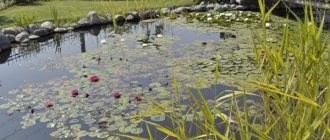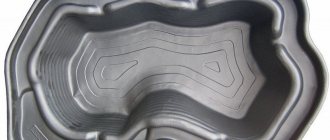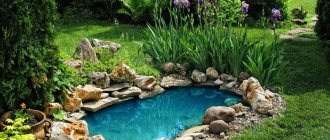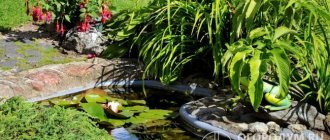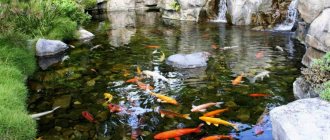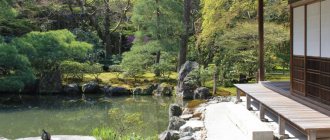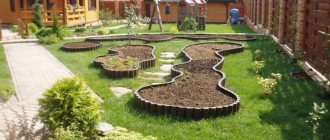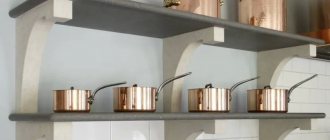The presence of a small pond on a summer cottage allows you to kill three birds with one stone, and water for irrigation is at hand, and the microclimate becomes softer, and you can start breeding perch or pike perch. Making a fish pond with your own hands is not as difficult as it might seem at first glance. Moreover, there are no fundamental differences in the design of decorative and stocked reservoirs.
A pond can be made with fishing spots
Types of fish ponds
In the simplest case, a reservoir for fish farming is a small round pit, no more than 1 m deep. The pond can be made ground for one season, but this is clearly not enough for normal fish farming. If you don’t have enough time to make a pond according to all the rules, you need to at least build it big and safe. If you make a large home fish pond with your own hands, you can be confident in the end result. In a small pond, fish practically do not grow, even if it is silver carp or crucian carp.
It is best to make a permanent pond according to one of the following schemes:
- Pond in a concrete or stone box;
- Pond - stakes with soil walls and film waterproofing;
- A dam with walls paved with rubble stones or cobblestones;
- Pond based on an old swimming pool.
Of all the above, the most popular are ground ponds with stone-paved walls or ponds lined with PVC film. It is clear that this is the cheapest and easiest way to make a pit for a fish pond, but in general there is nothing wrong with such simplicity.
It is better to make a fish pond with film insulation on sandy soil
If you wish, it will not be difficult to find a video with reviews on how convenient and easy it is to make a concrete pond for fish.
But in practice, not everything is so simple. Any mistake or omission can cause leaks and cracking of the walls. Therefore, for the first experiment, it is best to build a small ground pond with a mirror of 25-30 m2. This is more than enough to make your first stocking and get real experience in fish breeding. If everything goes well, then the ground one can be converted into a film one, and later even a box with concrete walls can be made.
Lighting installation and safety
Metal poles 2.5 m high are installed along the entire perimeter of the pond at a distance of 2.5 m - 3 m from each other. Then they are covered with chain-link mesh. Inside the fence it is necessary to install an electrical panel with a socket for the aerator and a switch.
Two LED lamps are installed on one of the posts. One of them should be directed towards the pond, and the second - in the opposite direction. You can install a light sensor on the lamps so that they turn on automatically in the evening or in cloudy weather.
The aerator and lamps will receive power from a common electrical network with the residential building. To avoid electric shock, a separate high-sensitivity RCD is installed in the house. If the wire breaks, the pump or aerator breaks, the protective device will stop the supply of electricity.
Minimum requirements for pond construction
It doesn’t take much intelligence to make a pit, cover the walls and fill the bowl with water. But even a person far from fish farming understands that it is one thing to simply build a pond in a fish garden with your own hands, and a completely different state of affairs if you have to maintain a reservoir and raise fry and food pike perch or perch on an ongoing basis.
Therefore, when planning a design, you must do the following:
- A small pier or section of shore paved with stone. If the pond is concrete, then it is better to add a canopy with handrails. You will have to feed the fish in the same place, otherwise some of the food will disappear;
- A clean water supply system and a quick drain system. It is better to bury the outlet pipes in the ground and bring them down the slope so that the 25-30 cubic meters of water discharged from the pond do not turn the area into a swamp;
- Build a frame or fence around the pond to install a film awning. In the summer, the water in a small pond can become very hot, and the awning does a good job of protecting the fry.
It is clear that the banks will have to be strengthened, made as stable as possible and capable of holding water even during periods of heavy rain. This is one of the reasons why fish ponds are not built on the ground surface like frame and inflatable pools.
Pond for raising trout with stone walls and sandy bottom
Some care tips
For fishing in the country to be successful, you need to properly care for the fish in the pond. It is very important that in the first years of life the fish grow and gain weight, as well as reproduce. Here are some more tips:
- Fish should be fed 1-2 times a day at a certain time in order to develop a reflex in the fish.
- The remaining food should be removed so that the water does not become acidic. Therefore, it is very convenient to use special feeders for feeding, which are much easier to clean.
- The number of individuals should be constantly monitored and excess fish should be caught.
- Sick fish must be isolated. It is very simple to calculate: usually such an individual swims near the surface in a circle on its side, and there is a white coating on its fins.
- In winter, it is imperative to drill holes in the ice so that the fish does not suffocate.
If you follow all the recommendations, then a rich catch at your dacha will be ensured all year round.
What to choose
The best option for breeding fish would be a ready-made fiberglass pool, albeit not new, but in working order, purchased at a huge discount. This is a ready-made pond with all the necessary elements - supply and drainage pipes, cleaning and waste disposal. Such a pool will cost about 20% of the cost of a new one. But the most important thing is that on its basis you can make a full-fledged fish pond with a volume of 50-60 cubic meters. In this case, the pool will need to be installed in a pit 80-100 cm below the site level.
If you rely only on available materials, then the best solution would be to make a ground pond with a three-layer coating of the walls and bottom, without any stonework. Such a reservoir will cost an order of magnitude cheaper than the previous option, and most importantly, you can always expand, deepen or even rebuild it with your own hands. True, the waterproofing will have to be replaced with a new one.
Site selection
To create a reservoir, a place is found that meets hydraulic parameters and fish farming rules. It is better to dig a pond on a hill so that rain and flood waters do not carry all the dirt from the summer cottage into it. In flat areas, the ground level is raised artificially using an embankment.
The pond is placed so that it is illuminated by sunlight for no more than 7 hours. The shadow on it can fall from the wall of the house or artificial fences. It is not advisable to make a pond in a place completely blocked from light. Sun deficiency has a bad effect on the growth of fry and aquatic flora. To construct a pond, choose a place with clay soil that does not permeate liquids well. An area free of stones is suitable.
Where is the best place to place it?
An open place on a site with a slight slope is considered optimal. Under a reservoir for fish breeding, it is best to use a site in the middle part of the allocated area, so that there is a free space of 2-3 m in length above and below the pond. Above the pit there will be a pier, a staircase for entering the water, and technological tanks and water supplies are also located here.
It is better to look for a place for a pit in a lowland or ravine
A protective embankment is made in the lower part of the pond, and there are also tools for cleaning and regulating water discharge. Low-growing shrubs are usually planted along the side lines of the pond. Thanks to the plantings, water loss from the surface of the reservoir is reduced, and less dust and debris gets in with the wind.
Advice! A fish pond must be made at a distance of at least 10-12 m from the house, summer kitchen or bathhouse, and 20 m from cesspools or drains.
The main enemy of fish is chemicals and soil bacteria, so plant protection products, detergents, technical liquids, dirty water from the house and sewerage should not get into the pond. In addition, you will need to install drainage gutters so that when it rains, water running through the ground does not fill the pool. Rainwater must be collected, settled and used only for technical purposes. To fill the pond, you will have to look for a spring or dig a well, ideally if you can find an underground stream.
Water supply and drainage
You should immediately think about how and from what source the water will come. This will decide the appearance and design of the bowl. You can supply water along the bottom of the reservoir. Then the pipe needs to be dug in and brought out at the bottom of the reservoir. Water can also come from an artificially made stream or water cascade.
To fill the pond, both tap water and water from an artificial well or collected rainwater are suitable. After filling the bowl, wait 3-4 days, wait until the water warms up and only then introduce the fish, this will create more comfortable conditions for it.
Water can be drained into a drainage ditch or a nearby stream. For this purpose, a pipe is installed at the bottom. You can also pump out water with a pump and use it for irrigation.
How to make a pond for breeding fish from film with your own hands at the dacha
After the area under the pond has been selected, you need to decide where to remove the soil selected from the pit. The best way to make temporary storage is to cover the area below the level of the reservoir with film and transfer 20-25 m3 of soil there.
Pit preparation
The simplest pond can be made according to the following scheme:
- We mark the area for the pit; this is easier to do with dry river sand or chalk. We define the dimensions of the future bowl as 7x4 m;
- We start digging the hole from the lower edge, remove the soil with a shovel or equipment and lay it on a film or tarpaulin laid around the perimeter of the pit;
- We trim the walls; with a reservoir depth of 1-1.2 m, the slope should be at least 70°. You need to make a step along the shore - remove it to the depth of the fertile layer. We fill the strip that has become free along the shore with a mixture of wet sand, clay and gravel, and carefully compact it all;
- We find roots on the walls of the reservoir and cut them out; we push liquid clay and large crushed stone into the resulting voids;
- The next step is to slightly moisten the walls and bottom of the pit, after which we actively compact the soil using a sledgehammer in the case of stony loam or a wooden tamper for any other types of soil;
- Pour a 20 cm layer of sand onto the bottom;
- We lay geotextiles on the walls and bottom; the fabric should lie on the surface without tension, preferably even with small folds. We overlap the edges onto the banks and secure them with cobblestones. At the bottom, lay a pressure of flat pebbles on the geotextile;
- The most crucial moment is to do waterproofing. We lay a thick polyethylene film 0.5-0.7 mm. We lay another layer of geotextile on top of the waterproofing.
In general, the reservoir pit is ready. If time is running out, you can stock the fish with fry. The pond can already be used for the first urgent “introduction” of fish. But for long-term use, you need to improve the bank, make a filtration system and plant plants in the ground.
How to make waterproofing
The most questions arise with the installation of wall insulation. For small dams, up to 1 meter, waterproofing can be made from black garden film. If the depth is more than 1.2-1.5 meters, we insulate the internal walls from thick PVC film.
If the pit is deeper, and in addition, the soil is exclusively loamy and saturated with groundwater, then a butyl rubber membrane will be required for the pond; it is often used for the construction of above-ground reservoirs and field water tanks. It can be laid on the walls of the pond as is, without fear of a discrepancy between the geometry of the membrane and the inner surface of the pit.
Film waterproofing is welded from several strips on a machine into one huge panel. Geotextile linings are joined using a sewing machine. The polyethylene film is laid out in a pit with folds at the corners; there is no need to cut or resolder.
Important! If a PVC membrane is used for waterproofing, then it is laid in a pit with a margin in the form of folds. The temperature of the water is always lower than that of the air, so after filling the pond, the PVC film will shrink and may break the fastening on the shore.
Attaching waterproofing on the shore
Polyethylene films are carefully straightened and laid out along the coastline. For fixing, you need to level and fill with sand and then gravel an area at least 40 cm wide. Next, we lay the film, again sprinkle with sand and press down with a large rubble stone. One way to make a fish pond with your own hands is shown in the video
To attach a butyl-styrene or PVC membrane, you will need to make a special pipe circuit. Having retreated a little from the coastline, we hammer into the ground posts made of a 20x20 mm square pipe. The heads must be made at a height of at least 50 mm above the platform level. Next, we weld the horizontal sections of the pipe to the perimeter posts. We pull the edge of the waterproofing panel onto the pipe, tuck it in, sprinkle it with gravel and press it down with rubble stone. If done correctly, the fish will not be able to tear the insulation into the water.
This method of fastening guarantees protection of the shore when choosing fish from the pond with a net.
Design and creation of an ecosystem
Moisture-loving sedge, hosta and ferns will help decorate the area around the pond. Calamus is a good choice for planting on the first underwater steps of a pond. For a large reservoir, marsh calamus, reaching 1 m in height, is preferable, and for a small reservoir, grass calamus, 40 cm high, is preferable. Pots with calligraphy can be placed along the steps. You should not plant it loosely - it will quickly grow throughout the entire water surface.
Since an artificial pond is a closed system, it cannot do without aquatic plants and algae. It simply requires plants that produce oxygen. The most active plants in this regard are hornwort, buttercup, marsh grass and water moss. Plant them in pots and place them at the bottom of the pond.
To prevent the pond from being polluted by excess algae and to protect it from overheating, deep-sea plants such as water lilies, brassicas and egg capsules will help. Their root system is located at depth, since the upper part floats on the surface.
New Year's crafts from pine cones: decor ideas from pine cones for the New YearDecorative elements made of stone as an integral part of landscape design
Smartphone case: overview of the main types
Also, floating non-rooting plants - bagel, watercolor, azolla - will save the water from overheating and blooming. The number of these plants needs to be regulated independently, as they can quickly cover the entire surface of the reservoir.
Many experts advise that when using tap or artesian water to fill a reservoir, pour 2-3 buckets of river water into it. This will help small algae multiply in it and create a familiar ecosystem for the fish.
It is imperative to constantly monitor the acid-base balance of water. The optimal value is 7-8 pH. When this indicator decreases to 5, limestone or soda should be added to the water until the desired pH values are obtained.
How to make an artificial concrete fish pond correctly
The use of concrete makes it possible to make a truly large reservoir, 60-70 cubic meters. The depth of the bowl can exceed 2 m, which allows the fish to winter safely and survive the summer heat without problems. The only negative is that making concrete ponds for fish with your own hands only makes sense for commercial use.
The procedure for constructing a concrete reservoir for growing fish:
- The first step is to make a pit. For these purposes, you will have to rent and use a small excavator, but first make access for the equipment to the pool bowl. The path will also come in handy when you need to deliver cement, sand, netting, and subsequently a container with fry or fish;
- The walls need to be made at an angle of 45-50o. This is the only way to achieve stability of a concrete bowl in floating soil. Immediately compact the clay with a metal tamper;
- Next, we lay the waterproofing film on the walls and bottom of the pit. You can use roofing felt or limit yourself to PVD500;
- The next stage is the most difficult; you will need to make a reinforcing outer layer without using formwork. We roll out and stretch the netting along the walls so that it does not slip; the wickerwork is often tied to stakes driven on the shore of the pond. At the bottom, on wooden plugs, we lay a grid of 8 mm tied reinforcement;
- Starting from the bottom, we throw the chain-link with a liquid solution and push it with a rule until the film. The concrete must completely cover the metal. At the same time, fill the bottom of the pond;
- We apply the second layer of concrete mixture like plaster; the thickness should be at least 20-30 mm. This layer is reinforced with ordinary steel mesh. We definitely add fiber and hydraulic additives to the concrete.
After the bowl is finally filled with concrete, you need to treat the walls with waterproofing butyl-styrene impregnation.
This will save the concrete walls of the pond from destruction in winter. Some owners prefer to paint the bowl with light-colored mastic; it is believed that this makes it easier to see the fish in the water.
Creating a pond without concreting
A pond without concreting is created using the same technology, but since concrete is used to strengthen the walls and bottom of the reservoir, you will have to find an alternative arrangement if you do not plan to use concreting.
In this case, you can simply thoroughly compact the soil in the reservoir or cover the bottom and walls with film. The latter method is considered the best, since plastic film greatly facilitates the process of cleaning the pond in the fall.
Peculiarities
There are no significant features that distinguish the construction of a pond from film and without concreting. To do this, you also need to choose a suitable place with a flat area and dense clay soil (Figure 9).
A prerequisite is to calculate the size of the reservoir. On average, 10-20 individuals need 10 liters of water. Based on this indicator, you can calculate the volume of an artificial reservoir and determine the optimal area.
Rules
According to the rules, construction of a pond without concreting begins with markings. It can be made using sand or a cord that is stretched around the perimeter of the future reservoir.
At the next stage, they begin to dig a pit. Its depth should be 2 meters, but for further arrangement of the bottom, the pit is made a little deeper. After this, in the case of using concrete, the bottom and walls are filled with mortar, but if you do not plan to use concrete, you need to carefully compact the bottom and walls, or cover them with thick dark plastic film.
Figure 9. Construction of a home pond without concrete
In the future, they will begin to develop the banks and the reservoir itself. The banks need to be strengthened so that the soil does not slide into the pond and clog it. A special nutrient substrate is placed at the bottom and aquatic plants are planted.
When arranging a pond without concreting, it should be borne in mind that this design is considered the simplest in the construction process, but in the future it may be difficult to clean the pond from silt, so it is better to use film or concrete as the main covering of the bottom and walls.
If the water in the pond does begin to bloom, the tips from the video will help you cope with this problem.
How to make a fish pond without film and concrete on the site
If you are planning a reservoir for commercial farming of pike perch or carp, then it is best to avoid using concrete. It is believed that these two types of fish require the cleanest, running, cool water possible. And besides, the more fish in the pond, the larger the bowl.
It is clear that casting a container with a mirror of 200-300 m2 from concrete will be incredibly expensive. You can make a bowl with clay walls without a film, but then there is a threat of erosion and washout of the material.
Therefore, we are building a reservoir using the old antiquated technology:
- You will need to prepare material in advance to strengthen the walls of the pit. For these purposes, we use an ordinary vine and thin oak stakes 2 m long;
- We dig a hole of the required size, in the center and in the area of the pier there will be a deep part, approximately 4x5 m, the rest will be occupied by a shallow with a depth of 1-1.2 m;
- We hammer stakes along the walls and sew them to the walls. We braid a vine between the stakes with a wave. We close the bottom in a similar way;
- We rub the wall wattle with clay, you can lay it out with pebbles. We simply place a stone on the bottom - a plaster. Shallow water for fish fry can be made with clay and covered with pebbles.
This type of pond design is different in that the water will be clean. Accordingly, the fish will not get sick. It is better to clad the walls with stone with a high quartz content, or better with quarry oxidized silicon. Over time, in running water, the pond will become overgrown with moss, but will still remain clean. Or you will have to make a filtration system through a pit filled with sand.
Strengthening the pond bank and planting algae
Planting vegetation in a man-made country house for fish farming is an important point, since you need to choose the right species. There are algae that clean man-made bets from foreign matter or produce oxygen. Both are very important for the formation of a normal ecosystem of an artificial reservoir. When planting vegetation, mesh pots or flowerpots are used - they are lowered to the bottom and attached to a plastic mesh located there.
Recommendations
For a country pond with a concrete bowl and a small amount of fish, you can use a scheme with a well. The essence of the structure of such a reservoir is shown in the diagram below.
The main difference is that a vertical pipe made of concrete rings is mounted into the bowl. The well goes deep into the sandy backfill of the aquifer, due to which the water level and temperature in the pond are maintained naturally.
Such a reservoir does not need to be replenished with water, and you don’t have to worry about overflow and loss of fish during heavy rains. True, there is one limitation - the water in the well must be potable and not contain bitterness or soil salts.
Commercial fish species
How and what kind of fish to breed in a pond? The reservoir, replenished with natural water, is suitable for fish such as trout, whitefish, and peled. Such a supply can be made from a stream blocked by a dam.
Trout loves a flowing, cold, constantly renewed environment. She looks spectacular in a shallow pool, shining with rainbow colors under the sun's rays.
A pond is dug when there is no natural reservoir on the site, so groundwater, rainwater and flood water are used for replenishment. In this case, it is suitable for growing river fish (crucian carp, crucian carp).
Crucian carp is unpretentious and less susceptible to disease. Carp has valuable juicy and tasty meat. It quickly gains mass and growth and easily coexists with other varieties.
Preparing tools and equipment
Before starting work, you should prepare the necessary tools. The amount and nature of equipment will vary significantly depending on the type of pond in your yard. For example, to create a small reservoir that will serve exclusively for decorative purposes, it is enough to prepare a hose, a shovel, containers for excavating earth and a level.
The more complex the configuration of the reservoir, the more elements will need to be prepared for its arrangement Source metastormbpm.info
See also: Catalog of country house projects worth up to 1 million rubles
If the functional load of the pool is higher, it is necessary to expand the above list to include the following elements:
- A filter necessary for water purification. It is also necessary to use it if it is planned to build a swimming pool.
- Sterilizer. It should be used only when constructing a swimming pool, since its task is to purify the water from growing algae.
- A pump through which water will be pumped in and out. Of course, this can also be done manually if it is not possible to purchase a pump.
- Aerator. This is a device whose task includes saturating water with oxygen. If you plan to build a pond at your dacha for fish breeding, you absolutely must purchase it.
It is also important to prepare consumables, including sand, small crushed stone, ropes, pegs, and large stones.
An artificial pond in a natural style fits harmoniously into the garden’s exterior Source yandex.net
Conditions necessary for fish reproduction
After completing the construction of a man-made reservoir, conditions necessary for the life of fish are created in it. In an unfavorable environment, they grow slowly and do not reproduce. The likelihood of their death increases. Fish need oxygen to live. Otherwise, all the inhabitants of the pond die. For this purpose, aquatic vegetation is planted. Suitable crops are purchased at florist shops. Plants taken from natural reservoirs are not planted in artificial ones, since they die in unusual conditions.
Vegetation is selected taking into account the depth of the pond. If it is of small depth, barnacle, chastuha, and susak are suitable. In the middle ones, pondweed or water lilies are planted. Deep ones are filled with loosestrife, Siberian guillemot, and basilisk.
The artificial pond is regularly cleaned, removing fallen leaves, debris, and grass. Otherwise they begin to rot. The oxygen content in water decreases sharply. All together leads to the death of the inhabitants of the reservoir. In order for fish to reproduce well, acidity is maintained at an optimal level. Each type has its own value for this indicator. On average, the pH level should be neutral.
For normal life, fish need micro- and macroelements. The health of pond fish is maintained by proper feeding. They need potassium salts, iron, phosphorus, nitrogen. To properly saturate water with chemical elements, special additives are added to it. They are added to commercially prepared food or homemade food.
Fish are released into an artificial pond only after the water has been heated to a temperature of +24°C and a silt layer has formed. To do this, the pond filled with water is left for a month. Then it is emptied without touching the silt that has accumulated at the bottom. Then fill it again with clean water and wait a few more days.
The fish are released into the man-made pond in several stages. First, 4-5 individuals are transferred into the water. They are monitored to make sure the water has everything they need to live. If the health of these fish is normal, everyone else is allowed in. In the future, the maintenance rules recommended for the bred species are applied.
Nutritional Features
In artificial reservoirs, fish are fed so that their weight increases at an accelerated rate. Omnivorous carp use any food. They mainly provide feed intended for poultry. Water is added to dry food to form a thick porridge. Instead of feed, they sometimes give cereals or legumes. They are pre-steamed to swell.
Important!
The fish are fed at one time, pouring food into a certain area of the reservoir. It is convenient to do this using special feeders in the form of pallets. They are easy to clean and make it possible to remove uneaten food residues from the pond.
Paddlefish require natural food - phytoplankton or zooplankton. For constant access to feed, minerals are added to the water. Conventional fertilizers are suitable - lime, potassium permanganate, superphosphate. They are first carefully dissolved in water, rather than throwing dry granules into the water. Otherwise, the fish may get poisoned.
Diseases
Pond fish often get sick even with good care. Therefore, they are constantly monitored in order to notice signs of infection or unusual behavior in time. External diseases are recognized by external signs. The fish develop a light coating on the body, the fins turn red, and wounds on the body. With some diseases, individuals itch against stones, show no interest in food, and swim in an unusual way.
The most common diseases that respond well to treatment:
- bulging eyes manifest as swelling and clouding of the eyes;
- with saprolengia, plaque forms on the fins, the fish becomes lethargic;
- with hexamethosis, there is no interest in food, the scales darken;
- with dropsy, the fish lies on the bottom, its scales bristle;
- with furunculosis, the scales darken and become covered with red spots, the gills become pale, and bulging eyes develop.
To treat these diseases, special drugs “Tsipropond”, “Ichthyostop”, “FMC” and others are used. They destroy parasites, bacteria and other pathogens that cause diseases in pond fish. Treatment with these drugs is gentle. They effectively help even when the exact diagnosis is unknown.
